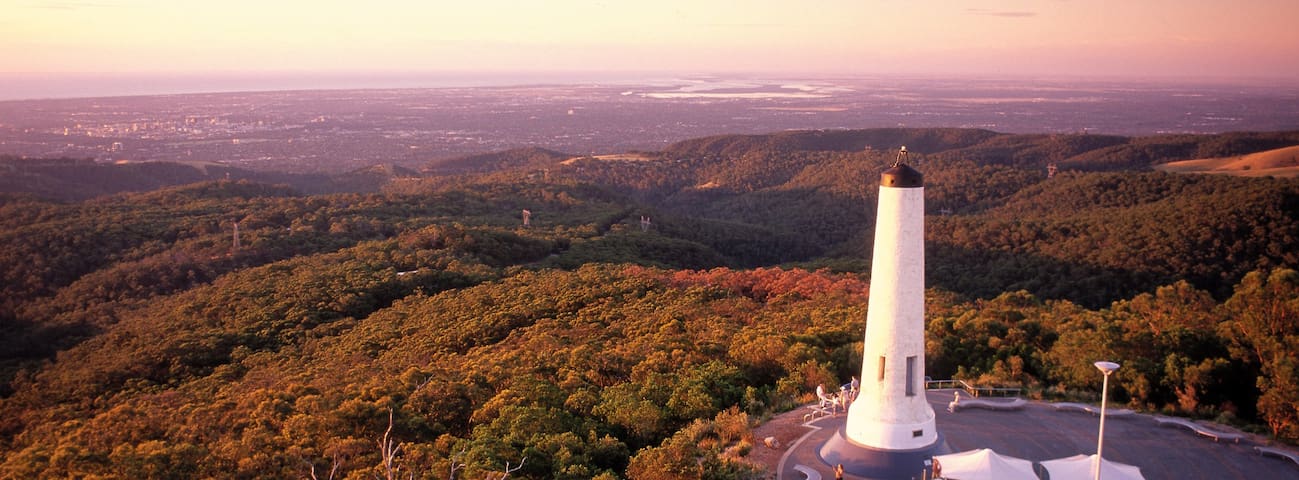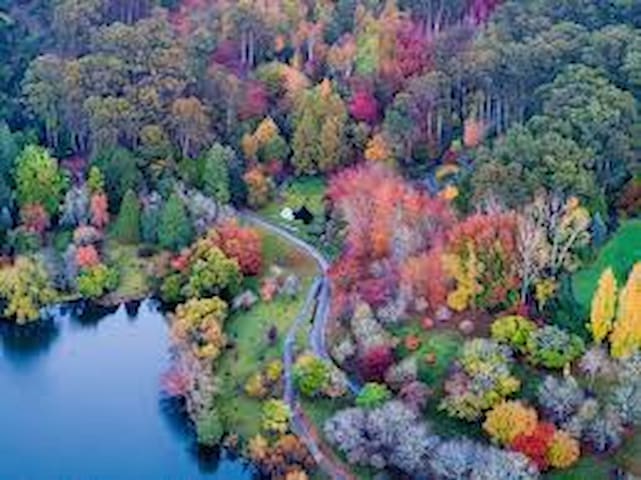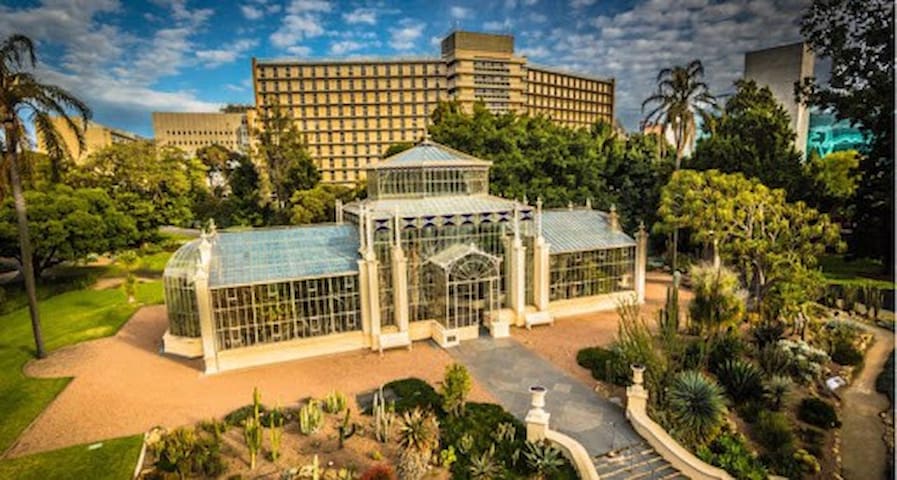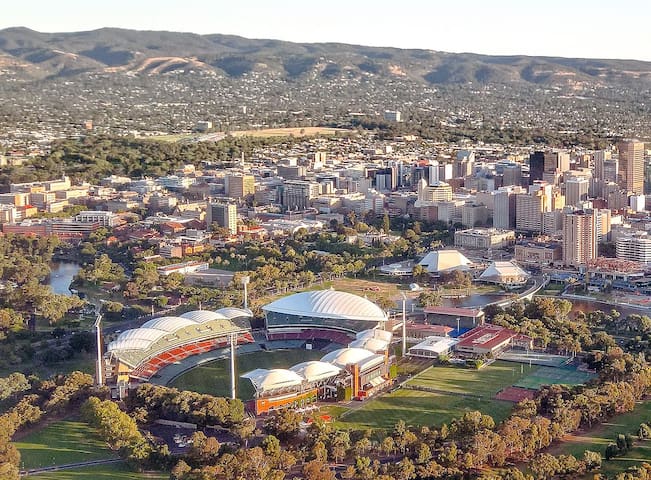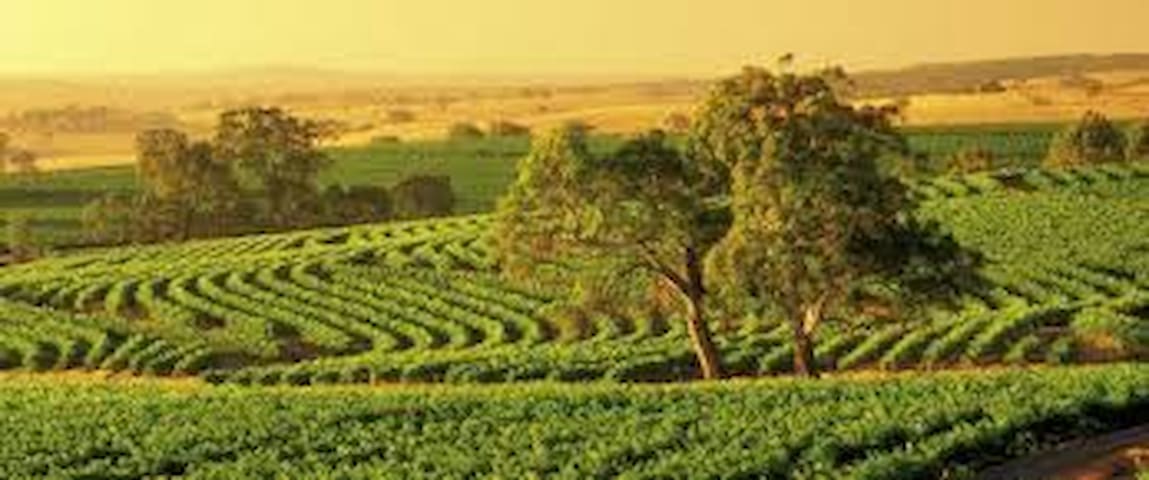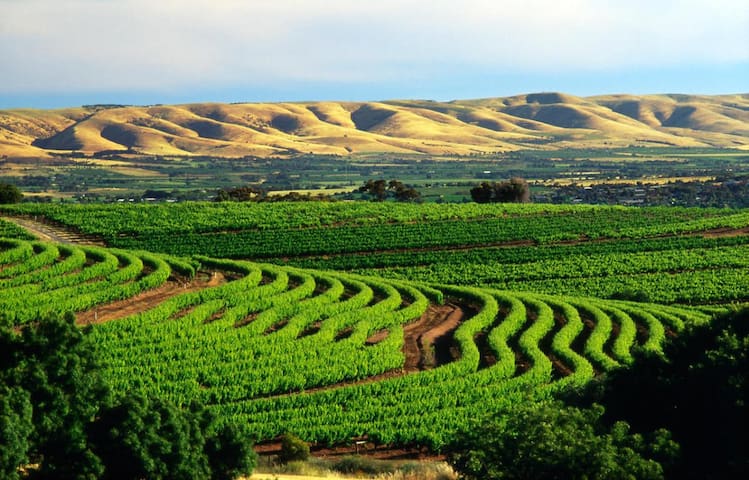Food Scene
European Cafe
219-219B The ParadeA bit noisy but great Italian Food
The Adelaide Central Market is one of the largest undercover fresh produce markets in the Southern Hemisphere, with 1 million kilograms of fresh produce delivered to the Market and sold every month. The Market offers a huge range of fresh food including fruit and vegetables, meat and poultry, seafood, cheeses, bakery, small goods and health foods, along with some of Adelaide's most frequented cafes and eateries. With more than 9.5 million visitations every year (up half a million from 2017), the Adelaide Central Market remains the food mecca for multicultural cuisine and fresh produce. In 2019, the Adelaide Central Market celebrated 150 years of continuous operation, making it the oldest food retail market in its original location in Australia. It is also a popular tourist attraction in the heart of Adelaide and is often referred to as the Central Market.
350 ντόπιοι το προτείνουν
Adelaide Central Market
60 Gouger StThe Adelaide Central Market is one of the largest undercover fresh produce markets in the Southern Hemisphere, with 1 million kilograms of fresh produce delivered to the Market and sold every month. The Market offers a huge range of fresh food including fruit and vegetables, meat and poultry, seafood, cheeses, bakery, small goods and health foods, along with some of Adelaide's most frequented cafes and eateries. With more than 9.5 million visitations every year (up half a million from 2017), the Adelaide Central Market remains the food mecca for multicultural cuisine and fresh produce. In 2019, the Adelaide Central Market celebrated 150 years of continuous operation, making it the oldest food retail market in its original location in Australia. It is also a popular tourist attraction in the heart of Adelaide and is often referred to as the Central Market.
Drinks & Nightlife
Udaberri Pintxos Y Vino
11-13 Leigh Stgreat atmosphere and good music, pintxos and vino
Bank Street Social
48 Hindley Stunder ground bar great décor and music
Cellar door for both local and international wines and antipasto platters
39 ντόπιοι το προτείνουν
East End Cellars
25 Vardon AveCellar door for both local and international wines and antipasto platters
Sightseeing
Mount Lofty Summit is located in the Adelaide Hills, 15km or a 20 minute drive from Adelaide’s CBD.
Rising over 710m above sea level, the summit provides a picturesque panoramic view over Adelaide’s city skyline, as far as Kangaroo Island and Yorke Peninsula on clear days.
The gift shop displays a range of Australian giftware and local goods, and also provides tourist information, local maps, brochures and regional visitor guides.
A popular place to watch the sunset, the summit is also place for walkers to rest after hiking on one of the many trails before descending the hill.
151 ντόπιοι το προτείνουν
Κορυφή Όρους Λόφτι
Mount Lofty Summit RoadMount Lofty Summit is located in the Adelaide Hills, 15km or a 20 minute drive from Adelaide’s CBD.
Rising over 710m above sea level, the summit provides a picturesque panoramic view over Adelaide’s city skyline, as far as Kangaroo Island and Yorke Peninsula on clear days.
The gift shop displays a range of Australian giftware and local goods, and also provides tourist information, local maps, brochures and regional visitor guides.
A popular place to watch the sunset, the summit is also place for walkers to rest after hiking on one of the many trails before descending the hill.
Mount Lofty Botanic Gardens, first opened in 1977, the crescent-shaped Mount Lofty Botanic Garden is situated on 97 hectares on the eastern slopes of Mount Lofty in the Adelaide Hills east of Adelaide in South Australia. The cooler, wetter location suits plants from temperate climates which are difficult to grow on the Adelaide Plains. Amongst the native Australian flora there are tree ferns, as well as exotic cultivated plants from cool climates including Rhododendron and Magnolia and the National Species Rose Collection. The Mount Lofty Botanic Garden, together with the Adelaide and Wittunga Botanic Gardens, is administered by the Botanic Gardens of South Australia, a State Government statutory authority.
151 ντόπιοι το προτείνουν
Κορυφή Όρους Λόφτι
Mount Lofty Summit RoadMount Lofty Botanic Gardens, first opened in 1977, the crescent-shaped Mount Lofty Botanic Garden is situated on 97 hectares on the eastern slopes of Mount Lofty in the Adelaide Hills east of Adelaide in South Australia. The cooler, wetter location suits plants from temperate climates which are difficult to grow on the Adelaide Plains. Amongst the native Australian flora there are tree ferns, as well as exotic cultivated plants from cool climates including Rhododendron and Magnolia and the National Species Rose Collection. The Mount Lofty Botanic Garden, together with the Adelaide and Wittunga Botanic Gardens, is administered by the Botanic Gardens of South Australia, a State Government statutory authority.
Adelaide Zoo is Australia's second oldest zoo (after Melbourne Zoo), and it is operated on a non-profit basis. It is located in the parklands just north of the city centre of Adelaide, South Australia. It is administered by the Royal Zoological Society of South Australia Incorporated, which is a full institutional member of the Zoo and Aquarium Association and the World Association of Zoos and Aquariums and which also administers the Monarto Safari Park near Murray Bridge.
The zoo houses about 300 native and exotic species, with over 3,000 animals on site. The zoo's most recent enclosures are in the second phase of the South-East Asia exhibit, known as Immersion, providing visitors with the experience of walking through the jungle, with Sumatran tigers and orangutans seemingly within reach.
Five buildings within the zoo have been listed as state heritage places on the South Australian Heritage Register including the front entrance on Frome Road and the former Elephant House. The zoo is also a botanical garden and the grounds contain significant exotic and native flora, including a Moreton Bay fig planted in 1877.
The giant panda exhibit, which opened in December 2009, is home to two giant pandas, Wang Wang and Funi, which will remain at the zoo until at least 2024.
259 ντόπιοι το προτείνουν
Ζωολογικός Κήπος της Αδελαΐδας
Frome RoadAdelaide Zoo is Australia's second oldest zoo (after Melbourne Zoo), and it is operated on a non-profit basis. It is located in the parklands just north of the city centre of Adelaide, South Australia. It is administered by the Royal Zoological Society of South Australia Incorporated, which is a full institutional member of the Zoo and Aquarium Association and the World Association of Zoos and Aquariums and which also administers the Monarto Safari Park near Murray Bridge.
The zoo houses about 300 native and exotic species, with over 3,000 animals on site. The zoo's most recent enclosures are in the second phase of the South-East Asia exhibit, known as Immersion, providing visitors with the experience of walking through the jungle, with Sumatran tigers and orangutans seemingly within reach.
Five buildings within the zoo have been listed as state heritage places on the South Australian Heritage Register including the front entrance on Frome Road and the former Elephant House. The zoo is also a botanical garden and the grounds contain significant exotic and native flora, including a Moreton Bay fig planted in 1877.
The giant panda exhibit, which opened in December 2009, is home to two giant pandas, Wang Wang and Funi, which will remain at the zoo until at least 2024.
The zoo was created in 1983 on land owned by the state government as a closed-to-the-public, purpose breeding area and endangered species sanctuary. In 1990, a study was undertaken to determine the feasibility of allowing public access to the zoo, and by 1993 it had been developed into a large educational facility, open to the public, with bus and walking tours.
Five major habitat exhibits have been developed, including the Asian steppes, arid north Africa, African plains, and Asian grasslands. The entire zoo is surrounded with vermin-proof fencing to keep the habitat as self-contained as possible. The area is not irrigated, and is populated primarily with native flora to cut down on water consumption and erosion in the semi-arid region. The roads and trails within the zoo are constructed of local materials to keep them low maintenance, and to allow them to be easily re-integrated into the habitat should the need arise. Waste water is recycled, and as much as possible, solar power is used for electric fencing needs.
In late 2019, Monarto Zoo began a three-year project to convert itself into a safari park with luxury resort facilities. As part of the overhaul, it is transitioning its branding to be "Monarto Safari Park" by 2021. Monarto will also become the largest park outside of Africa.
90 ντόπιοι το προτείνουν
Ζωολογικός Κήπος Μονάρτο
63 Old Princes HwyThe zoo was created in 1983 on land owned by the state government as a closed-to-the-public, purpose breeding area and endangered species sanctuary. In 1990, a study was undertaken to determine the feasibility of allowing public access to the zoo, and by 1993 it had been developed into a large educational facility, open to the public, with bus and walking tours.
Five major habitat exhibits have been developed, including the Asian steppes, arid north Africa, African plains, and Asian grasslands. The entire zoo is surrounded with vermin-proof fencing to keep the habitat as self-contained as possible. The area is not irrigated, and is populated primarily with native flora to cut down on water consumption and erosion in the semi-arid region. The roads and trails within the zoo are constructed of local materials to keep them low maintenance, and to allow them to be easily re-integrated into the habitat should the need arise. Waste water is recycled, and as much as possible, solar power is used for electric fencing needs.
In late 2019, Monarto Zoo began a three-year project to convert itself into a safari park with luxury resort facilities. As part of the overhaul, it is transitioning its branding to be "Monarto Safari Park" by 2021. Monarto will also become the largest park outside of Africa.
The South Australian Museum is a natural history museum and research institution in Adelaide, South Australia, founded in 1856 and owned by the Government of South Australia. It occupies a complex of buildings on North Terrace in the cultural precinct of the Adelaide Parklands. Plans are under way to split its Australian Aboriginal cultural collection (the largest in the world), some of which will be housed in a new building housing these along with other works of art, in a new National Gallery for Aboriginal Art and Cultures.
246 ντόπιοι το προτείνουν
Νότιο Αυστραλιανό Μουσείο
North TerraceThe South Australian Museum is a natural history museum and research institution in Adelaide, South Australia, founded in 1856 and owned by the Government of South Australia. It occupies a complex of buildings on North Terrace in the cultural precinct of the Adelaide Parklands. Plans are under way to split its Australian Aboriginal cultural collection (the largest in the world), some of which will be housed in a new building housing these along with other works of art, in a new National Gallery for Aboriginal Art and Cultures.
The Art Gallery of South Australia, established as the National Gallery of South Australia in 1881, is located in Adelaide. It is the most significant visual arts museum in the Australian state of South Australia. It has a collection of almost 45,000 works of art, making it the second largest state art collection in Australia (after the National Gallery of Victoria). As part of North Terrace cultural precinct, the Gallery is flanked by the South Australian Museum to the west and the University of Adelaide to the east.
As well as its permanent collection, which is especially renowned for its collection of Australian art, hosts the annual Festival of Contemporary Aboriginal and Torres Strait Islander Art known as Tarnanthi, displays a number of visiting exhibitions each year and also contributes travelling exhibitions to regional galleries. European (including British), Asian and North American art are also well represented in its collections.
280 ντόπιοι το προτείνουν
Art Gallery of South Australia
North TerraceThe Art Gallery of South Australia, established as the National Gallery of South Australia in 1881, is located in Adelaide. It is the most significant visual arts museum in the Australian state of South Australia. It has a collection of almost 45,000 works of art, making it the second largest state art collection in Australia (after the National Gallery of Victoria). As part of North Terrace cultural precinct, the Gallery is flanked by the South Australian Museum to the west and the University of Adelaide to the east.
As well as its permanent collection, which is especially renowned for its collection of Australian art, hosts the annual Festival of Contemporary Aboriginal and Torres Strait Islander Art known as Tarnanthi, displays a number of visiting exhibitions each year and also contributes travelling exhibitions to regional galleries. European (including British), Asian and North American art are also well represented in its collections.
The Adelaide Botanic Garden is a 51-hectare (130-acre) public garden at the north-east corner of the Adelaide city centre, in the Adelaide Park Lands. It encompasses a fenced garden on North Terrace (between Lot Fourteen, the site of the old Royal Adelaide Hospital, and the National Wine Centre) and behind it the Botanic Park (adjacent to the Adelaide Zoo). Work was begun on the site in 1855, with its official opening to the public on 4 October 1857.
The Adelaide Botanic Garden and adjacent State Herbarium of South Australia, together with the Wittunga and Mt Lofty Botanic Gardens, are administered by the Board of the Botanic Gardens and State Herbarium, a State Government statutory authority.
Botanic Road
Botanic RoadThe Adelaide Botanic Garden is a 51-hectare (130-acre) public garden at the north-east corner of the Adelaide city centre, in the Adelaide Park Lands. It encompasses a fenced garden on North Terrace (between Lot Fourteen, the site of the old Royal Adelaide Hospital, and the National Wine Centre) and behind it the Botanic Park (adjacent to the Adelaide Zoo). Work was begun on the site in 1855, with its official opening to the public on 4 October 1857.
The Adelaide Botanic Garden and adjacent State Herbarium of South Australia, together with the Wittunga and Mt Lofty Botanic Gardens, are administered by the Board of the Botanic Gardens and State Herbarium, a State Government statutory authority.
Cleland Conservation Park is a protected area located in the Adelaide Hills, South Australia about 22 kilometres (14 mi) south-east of the Adelaide city centre. Cleland Conservation Park conserves a significant area of natural bushland on the Adelaide Hills face and includes the internationally popular Cleland Wildlife Park and the popular tourist destinations of Mount Lofty summit and Waterfall Gully. It is maintained by the South Australian Department of Environment, Water and Natural Resources.
The conservation park was named for Sir John Burton Cleland (1878-1971), a renowned naturalist, microbiologist, mycologist and ornithologist, and member of the Royal Society of South Australia. After a career in medicine and pathology, Cleland became keenly interested in wildlife conservation.
The conservation park occupies land in the gazetted suburbs of Cleland, Crafers and Waterfall Gully.
75 ντόπιοι το προτείνουν
Πάρκο Φύλαξης Cleland
Cleland Conservation Park is a protected area located in the Adelaide Hills, South Australia about 22 kilometres (14 mi) south-east of the Adelaide city centre. Cleland Conservation Park conserves a significant area of natural bushland on the Adelaide Hills face and includes the internationally popular Cleland Wildlife Park and the popular tourist destinations of Mount Lofty summit and Waterfall Gully. It is maintained by the South Australian Department of Environment, Water and Natural Resources.
The conservation park was named for Sir John Burton Cleland (1878-1971), a renowned naturalist, microbiologist, mycologist and ornithologist, and member of the Royal Society of South Australia. After a career in medicine and pathology, Cleland became keenly interested in wildlife conservation.
The conservation park occupies land in the gazetted suburbs of Cleland, Crafers and Waterfall Gully.
Adelaide Oval is a sports ground in Adelaide, South Australia, located in the parklands between the city centre and North Adelaide. The venue is predominantly used for cricket and Australian rules football, but has also played host to rugby league, rugby union, soccer, tennis among other sports as well as regularly being used to hold concerts. Austadiums.com described Adelaide Oval as being "one of the most picturesque Test cricket grounds in Australia, if not the world". After the completion of the ground‘s most recent redevelopment in 2014, sports journalist Gerard Whateley described the venue as being "the most perfect piece of modern architecture because it's a thoroughly contemporary stadium with all the character that it's had in the past".
Adelaide Oval has been headquarters to the South Australian Cricket Association since 1871 and South Australian National Football League since 2014.[6] The stadium is managed by the Adelaide Oval Stadium Management Authority. Its record crowd for cricket was 55,317 for the Second Ashes Test on 2 December 2017 and its record crowd for an Australian rules football match was 62,543 at the 1965 SANFL Grand Final between Port Adelaide and Sturt.
45 ντόπιοι το προτείνουν
Adelaide
Adelaide Oval is a sports ground in Adelaide, South Australia, located in the parklands between the city centre and North Adelaide. The venue is predominantly used for cricket and Australian rules football, but has also played host to rugby league, rugby union, soccer, tennis among other sports as well as regularly being used to hold concerts. Austadiums.com described Adelaide Oval as being "one of the most picturesque Test cricket grounds in Australia, if not the world". After the completion of the ground‘s most recent redevelopment in 2014, sports journalist Gerard Whateley described the venue as being "the most perfect piece of modern architecture because it's a thoroughly contemporary stadium with all the character that it's had in the past".
Adelaide Oval has been headquarters to the South Australian Cricket Association since 1871 and South Australian National Football League since 2014.[6] The stadium is managed by the Adelaide Oval Stadium Management Authority. Its record crowd for cricket was 55,317 for the Second Ashes Test on 2 December 2017 and its record crowd for an Australian rules football match was 62,543 at the 1965 SANFL Grand Final between Port Adelaide and Sturt.
RoofClimb offers unparalleled 360 degree views of Adelaide and beyond, from our stunning coastline to picturesque foothills.
Our specially trained RoofClimb Leaders guide you across the rooftop of the iconic Oval’s Western Stand before navigating to the Riverbank platform, perched 50 metres over the hallowed turf. Sit in the world’s first rooftop stadium seats and learn the secrets and stories that shaped Adelaide’s rich history.
An experience like no other.
16 ντόπιοι το προτείνουν
RoofClimb Adelaide Oval
War Memorial DriveRoofClimb offers unparalleled 360 degree views of Adelaide and beyond, from our stunning coastline to picturesque foothills.
Our specially trained RoofClimb Leaders guide you across the rooftop of the iconic Oval’s Western Stand before navigating to the Riverbank platform, perched 50 metres over the hallowed turf. Sit in the world’s first rooftop stadium seats and learn the secrets and stories that shaped Adelaide’s rich history.
An experience like no other.
Food and Wine Experience
The Barossa Valley is a renowned wine-producing region northeast of Adelaide, in South Australia. The area encompasses towns such as Tanunda, Angaston and Nuriootpa, and an array of high-profile wineries offering tours and cellar-door tastings. Shiraz grapes are the local speciality. The stone cottages and Lutheran churches throughout the region are testament to a 19th-century wave of German settlers.
106 ντόπιοι το προτείνουν
Barossa Valley
The Barossa Valley is a renowned wine-producing region northeast of Adelaide, in South Australia. The area encompasses towns such as Tanunda, Angaston and Nuriootpa, and an array of high-profile wineries offering tours and cellar-door tastings. Shiraz grapes are the local speciality. The stone cottages and Lutheran churches throughout the region are testament to a 19th-century wave of German settlers.
The Clare Valley is a valley located in South Australia about 100 kilometres (62 miles) north of Adelaide in the Clare and Gilbert Valleys council area. It is the river valley formed by the Hutt River but is also strongly associated with the roughly parallel Hill River. The valley is traversed by the Horrocks Highway and the towns in the valley along that route from south to north are Auburn, Leasingham, Watervale, Penwortham, Sevenhill and Clare. The geographical feature has given rise to the Clare Valley wine region designation, a notable winegrowing region of Australia
21 ντόπιοι το προτείνουν
Clare Valley
The Clare Valley is a valley located in South Australia about 100 kilometres (62 miles) north of Adelaide in the Clare and Gilbert Valleys council area. It is the river valley formed by the Hutt River but is also strongly associated with the roughly parallel Hill River. The valley is traversed by the Horrocks Highway and the towns in the valley along that route from south to north are Auburn, Leasingham, Watervale, Penwortham, Sevenhill and Clare. The geographical feature has given rise to the Clare Valley wine region designation, a notable winegrowing region of Australia
Only 45 minutes south of Adelaide in South Australia, McLaren Vale is home to sustainable wine growing, world-class wines and culinary experiences, as well as pristine natural attractions and unparalleled tourism offerings.
South Australia's viticultural origins began in McLaren Vale and our region's Mediterranean climate continues to drive our region's wine style and diverse food culture.
Best known for Shiraz, McLaren Vale also excels in the production of ultra-premium Grenache and Cabernet. Spanish and Italian varieties such as Fiano, Vermentino, Tempranillo and Sangiovese are also very well suited climatically and provide wine lovers with yet another layer of discovery. Over one third of our cellar doors offer local produce as part of the tasting experience - from high-end, starred restaurants to casual platters - there is a wine and food combination to suit any taste.
Our region's 30 kilometres of breath-taking coastline and ranges define McLaren Vale's boundaries, and the distinct landscapes and environment within.
Over one third of our cellar doors offer local produce as part of the tasting experience - from high-end, starred restaurants to casual platters - there is a wine and food combination to suit any taste.
Our region's 30 kilometres of breath-taking coastline and ranges define McLaren Vale's boundaries, and the distinct landscapes and environment within.
267 ντόπιοι το προτείνουν
McLaren Vale
Only 45 minutes south of Adelaide in South Australia, McLaren Vale is home to sustainable wine growing, world-class wines and culinary experiences, as well as pristine natural attractions and unparalleled tourism offerings.
South Australia's viticultural origins began in McLaren Vale and our region's Mediterranean climate continues to drive our region's wine style and diverse food culture.
Best known for Shiraz, McLaren Vale also excels in the production of ultra-premium Grenache and Cabernet. Spanish and Italian varieties such as Fiano, Vermentino, Tempranillo and Sangiovese are also very well suited climatically and provide wine lovers with yet another layer of discovery. Over one third of our cellar doors offer local produce as part of the tasting experience - from high-end, starred restaurants to casual platters - there is a wine and food combination to suit any taste.
Our region's 30 kilometres of breath-taking coastline and ranges define McLaren Vale's boundaries, and the distinct landscapes and environment within.
Over one third of our cellar doors offer local produce as part of the tasting experience - from high-end, starred restaurants to casual platters - there is a wine and food combination to suit any taste.
Our region's 30 kilometres of breath-taking coastline and ranges define McLaren Vale's boundaries, and the distinct landscapes and environment within.
The Coonawarra wine region is a wine region (374km from Adelaide - aprrox 4hrs) centred on the town of Coonawarra in the Limestone Coast zone of South Australia. It is known for the Cabernet Sauvignon wines produced on its "terra rossa" soil. Coonawarra is an Aboriginal word meaning "Honeysuckle". It is about 380 km southeast of Adelaide, close to the border with Victoria.
The first vines were planted by John Riddoch at Yallum, South Australia in 1890. Only the Redman family of Rouge Homme continued to produce table wine during this period, during which Shiraz was the main grape variety grown.
Fortunes changed when Samuel Wynn recognised the potential of the strip of terra rossa soil, and bought the original Riddoch cellars in 1951. Led by Wynns and Penfolds, Coonawarra was to play a leading role in the transformation of the Australian wine industry as it changed from making fortified wines to conventional table wines.
30 ντόπιοι το προτείνουν
Coonawarra
The Coonawarra wine region is a wine region (374km from Adelaide - aprrox 4hrs) centred on the town of Coonawarra in the Limestone Coast zone of South Australia. It is known for the Cabernet Sauvignon wines produced on its "terra rossa" soil. Coonawarra is an Aboriginal word meaning "Honeysuckle". It is about 380 km southeast of Adelaide, close to the border with Victoria.
The first vines were planted by John Riddoch at Yallum, South Australia in 1890. Only the Redman family of Rouge Homme continued to produce table wine during this period, during which Shiraz was the main grape variety grown.
Fortunes changed when Samuel Wynn recognised the potential of the strip of terra rossa soil, and bought the original Riddoch cellars in 1951. Led by Wynns and Penfolds, Coonawarra was to play a leading role in the transformation of the Australian wine industry as it changed from making fortified wines to conventional table wines.
The Wine Discovery Journey at the National Wine Centre is a must-see experience in the heart of Adelaide. Whether you’re a tourist or local, we’re certain you will learn something new and exciting with every visit. Book a guided tour with one of our knowledgeable hosts and be enlightened on the wonderful world of Australian wine, then head downstairs to the Wined Bar for a wine tasting experience like no other.T he National Wine Centre of Australia offers flexible spaces with natural lighting and spectacular architecture. The complex also features outdoor terrace areas with views of the Centre's own vineyard and the Botanic Gardens.
43 ντόπιοι το προτείνουν
National Wine Centre
Botanic RoadThe Wine Discovery Journey at the National Wine Centre is a must-see experience in the heart of Adelaide. Whether you’re a tourist or local, we’re certain you will learn something new and exciting with every visit. Book a guided tour with one of our knowledgeable hosts and be enlightened on the wonderful world of Australian wine, then head downstairs to the Wined Bar for a wine tasting experience like no other.T he National Wine Centre of Australia offers flexible spaces with natural lighting and spectacular architecture. The complex also features outdoor terrace areas with views of the Centre's own vineyard and the Botanic Gardens.
Walking Trails
Mount Lofty Summit, the majestic peak of the Mount Lofty Ranges in the Adelaide Hills, provides spectacular panoramic views across Adelaide's city skyline to the coast. Each year more than 350,000 people visit the peak which rises more than 710 metres above sea level.
From the summit you can follow the popular walk down to Waterfall Gully, join the Heysen Trail or stroll along a walking trail through native bushland to Cleland Wildlife Park.
Visit the Mount Lofty Summit Visitor Information Outlet and Gift Shop and speak to our friendly tourism experts about your next South Australian adventure. Get the latest maps and walking trail advice, and browse the exceptional range of quality souvenirs, locally produced gifts and a great range of clothing.
151 ντόπιοι το προτείνουν
Κορυφή Όρους Λόφτι
Mount Lofty Summit RoadMount Lofty Summit, the majestic peak of the Mount Lofty Ranges in the Adelaide Hills, provides spectacular panoramic views across Adelaide's city skyline to the coast. Each year more than 350,000 people visit the peak which rises more than 710 metres above sea level.
From the summit you can follow the popular walk down to Waterfall Gully, join the Heysen Trail or stroll along a walking trail through native bushland to Cleland Wildlife Park.
Visit the Mount Lofty Summit Visitor Information Outlet and Gift Shop and speak to our friendly tourism experts about your next South Australian adventure. Get the latest maps and walking trail advice, and browse the exceptional range of quality souvenirs, locally produced gifts and a great range of clothing.

